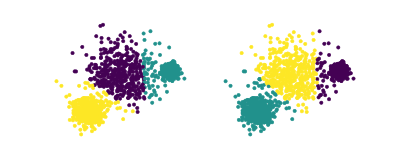
Search
Rand index

The Rand index or Rand measure (named after William M. Rand) in statistics, and in particular in data clustering, is a measure of the similarity between two data clusterings. A form of the Rand index may be defined that is adjusted for the chance grouping of elements, this is the adjusted Rand index. The Rand index is the accuracy of determining if a link belongs within a cluster or not.
Rand index
Definition
Given a set of elements and two partitions of to compare, , a partition of S into r subsets, and , a partition of S into s subsets, define the following:
- , the number of pairs of elements in that are in the same subset in and in the same subset in
- , the number of pairs of elements in that are in different subsets in and in different subsets in
- , the number of pairs of elements in that are in the same subset in and in different subsets in
- , the number of pairs of elements in that are in different subsets in and in the same subset in
The Rand index, , is:
Intuitively, can be considered as the number of agreements between and and as the number of disagreements between and .
Since the denominator is the total number of pairs, the Rand index represents the frequency of occurrence of agreements over the total pairs, or the probability that and will agree on a randomly chosen pair.
is calculated as .
Similarly, one can also view the Rand index as a measure of the percentage of correct decisions made by the algorithm. It can be computed using the following formula:
- where is the number of true positives, is the number of true negatives, is the number of false positives, and is the number of false negatives.
Properties
The Rand index has a value between 0 and 1, with 0 indicating that the two data clusterings do not agree on any pair of points and 1 indicating that the data clusterings are exactly the same.
In mathematical terms, a, b, c, d are defined as follows:
- , where
- , where
- , where
- , where
for some
Relationship with classification accuracy
The Rand index can also be viewed through the prism of binary classification accuracy over the pairs of elements in . The two class labels are " and are in the same subset in and " and " and are in different subsets in and ".
In that setting, is the number of pairs correctly labeled as belonging to the same subset (true positives), and is the number of pairs correctly labeled as belonging to different subsets (true negatives).
Adjusted Rand index
The adjusted Rand index is the corrected-for-chance version of the Rand index. Such a correction for chance establishes a baseline by using the expected similarity of all pair-wise comparisons between clusterings specified by a random model. Traditionally, the Rand Index was corrected using the Permutation Model for clusterings (the number and size of clusters within a clustering are fixed, and all random clusterings are generated by shuffling the elements between the fixed clusters). However, the premises of the permutation model are frequently violated; in many clustering scenarios, either the number of clusters or the size distribution of those clusters vary drastically. For example, consider that in K-means the number of clusters is fixed by the practitioner, but the sizes of those clusters are inferred from the data. Variations of the adjusted Rand Index account for different models of random clusterings.
Though the Rand Index may only yield a value between 0 and +1, the adjusted Rand index can yield negative values if the index is less than the expected index.
The contingency table
Given a set S of n elements, and two groupings or partitions (e.g. clusterings) of these elements, namely and , the overlap between X and Y can be summarized in a contingency table where each entry denotes the number of objects in common between and : .
Definition
The original Adjusted Rand Index using the Permutation Model is
where are values from the contingency table.
See also
- Simple matching coefficient
References
External links
- C++ implementation with MATLAB mex files
Text submitted to CC-BY-SA license. Source: Rand index by Wikipedia (Historical)
Owlapps.net - since 2012 - Les chouettes applications du hibou


